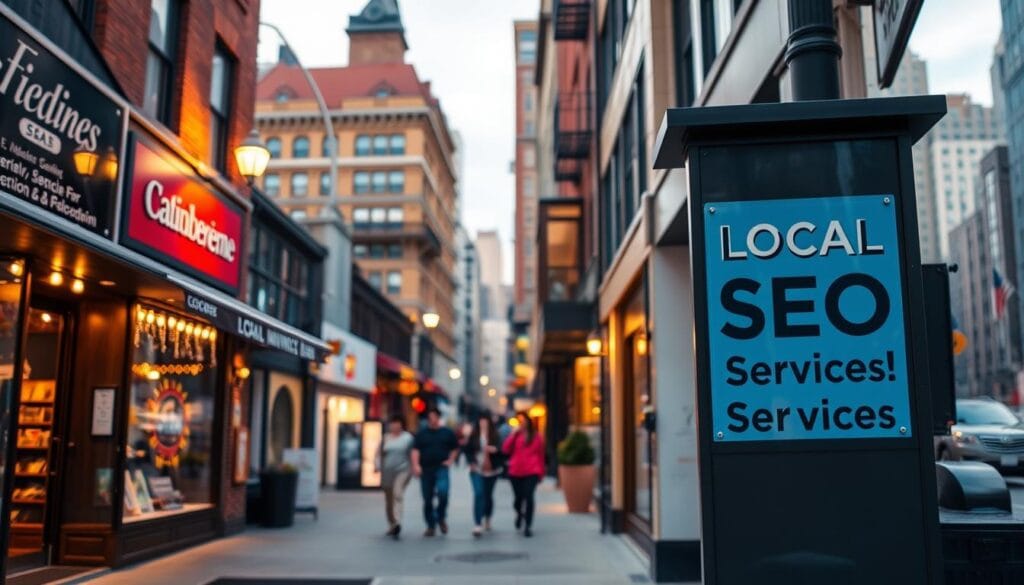80% of U.S. consumers search online for nearby businesses each week. That single metric exposes a large gap: tier-2 and tier-3 markets are underserved, and premium brands are leaving revenue on the table.
We combine expert insight and real-world outcomes to seize that advantage. When intent meets visibility, conversions follow. Our approach blends disciplined seo work and reputation signals so high-intent searchers find you at the moment they decide.
If people can’t find your brand, they can’t buy from you. We build accountable systems that convert search into measurable foot traffic and higher-margin sales. This article maps a repeatable strategy for small business operators in secondary metros, with timelines, priority actions, and ROI focus.
We favor compounding tactics over quick tricks. Accurate listings, strong reviews, and targeted location content create a durable conversion engine for premium services in smaller U.S. markets.
Key Takeaways
- 80% weekly search demand creates a clear market opportunity in secondary cities.
- Prioritize accuracy and reviews to boost credibility and conversions.
- Combine on-platform optimization and off-platform signals for sustained visibility.
- Measure traffic and in-store visits, not vanity metrics.
- Follow a timeline-driven strategy to compress time-to-value and scale predictably.
The surge of local search and why it’s your unfair advantage right now
An 80% weekly search rate turns everyday queries into measurable retail demand. Seventy-two percent of consumers use Google to find nearby business information, so presence in maps and packs is a core competitive asset.
In tier-2 and tier-3 metros, search is less crowded and more actionable. That lower saturation creates an operational advantage for premium brands that move fast with focused seo and citation work. Visibility compounds: listings, reviews, and links build a durable presence that feeds steady foot traffic.
Mobile “near me” growth means customers are ready to act. Being prominent in a map result converts intent into calls, directions, and visits. This is precision marketing — we capture in-region demand and translate it into higher-margin sales velocity.

| Signal | Immediate Impact | Priority |
|---|---|---|
| Complete profile | Higher map rankings | High |
| Citations & links | Improved visibility | Medium |
| Reviews & responses | Trust, more calls | High |
- Act now: first movers lock in maps equity and sustainable results.
- Focus on intent signals, not ad spend, to lower acquisition cost.
Foundations that make local SEO work in smaller U.S. markets
When a searcher types an intent-driven query, three signals decide whether they call, click, or walk in.
Understanding intent, the Local Pack, and Maps visibility
Proximity, relevance, and prominence govern search results in map packs and Maps. Queries with local intent trigger these containers, and users expect instant answers.
Complete profiles and consistent citations raise prominence. Optimizing your Google Business Profile increases Maps visibility and drives more calls and visits.

Why consistency beats hacks: the long game of sustainable ranking
Authority accrues slowly. Reviews, local links, and steady content cadence shift engines of trust in your favor over time.
Weekly optimizations, review workflows, and accurate category data outperform one-off bursts. Expect lag times; seo is compounding capital that delivers measurable increases in calls, directions, and foot traffic.
- Systemize listings, photos, and attributes.
- Track Maps actions, calls, and visits to prove ROI.
- Scale with playbooks that preserve precision across locations.
Local SEO for Small Business: Build and optimize your Google Business Profile
A verified and complete profile is the single fastest win to increase in-store traffic. We treat the google business profile as a revenue asset: verification, accuracy, and steady engagement drive real results.
Start with verification and keep information pristine. Incorrect details cost calls and trust. Verify your address, confirm phone numbers, and complete categories and services precisely.
- Create & verify: Claim your google business account and confirm address to earn full editing controls.
- Complete every field: Categories, business profile description, services, and keywords that reflect what customers search.
- Photos & hours: Upload exterior, interior, product, and team images. Publish holiday hours and real-time changes.
- Attributes: Add access, payment, and amenities so customers decide faster and call more often.
- Posts & Q&A: Publish short weekly updates and pre-answer common questions to reduce friction.
- Mobile-first: Prioritize tap-to-call, short descriptions, and fast-loading media for on-the-go searchers.
“Accuracy and activity on your business profile directly increase visibility and customer actions.”
Systemize this checklist. Monitor suggested edits, encourage reviews, and schedule weekly optimization. These habits preserve trust and compound ROI.
Citations, NAP consistency, and data accuracy that protect rankings
Data accuracy is both a ranking safeguard and a revenue control. Citation building across directories, social profiles, and review platforms increases online visibility and drives measurable foot traffic.
Inconsistent details cost customers. Sixty-two percent of consumers would avoid using a business if they find incorrect information online, so speed matters when we correct listings.
Where to list: core directories, industry sites, and chambers
| Directory Type | Priority | Why it matters |
|---|---|---|
| Major aggregators (Google, Bing, YP) | High | Foundational presence and maps signals |
| Industry vertical sites | Medium | Authority and referral traffic |
| Local chamber & associations | Medium | Trust signals and community discoverability |
Fixing inconsistencies fast: a remediation workflow
We standardize NAP formatting, mirror those details with structured data on the site, and centralize control for multi-location clients.
- Audit listings quarterly to detect duplicates and mismatches.
- Apply a 24–48 hour change-log process when hours or services shift.
- Track outcomes—clicks to call, directions, and site visits—to prove ROI.
“Accuracy converts search signals into real visits; treat your listings as mission-critical assets.”
Reviews as a growth engine: reputation that converts nearby customers
Reputation drives discovery: a steady stream of authentic reviews turns browsers into buyers. We treat review management as a revenue system—capture, respond, surface, and measure.
Ethical capture and response frameworks
Engineer review flows at key moments—after purchase, service completion, or during follow-up. Ask briefly, make it easy, and never offer incentives that violate platform rules.
We use templates that keep tone consistent and speed responses. That preserves trust and scales across locations.
Turning negatives into trust signals
Respond to every review within 24–48 hours. Timely, empathetic replies convert complaints into proof of care.
Apologize, propose a solution, and invite offline escalation. Public recovery builds credibility and improves search performance.
Showcasing social proof on your site and profile
Publish top reviews on your website and highlight them on your profile. Integrate widgets and review schema to surface star ratings in search and lift click-through.
- Monitor sentiment by category—speed, quality, price, staff—to guide content and service fixes.
- Encourage customers to mention services and location naturally to strengthen relevance.
- Track lift in calls, direction requests, and bookings after review surges to quantify ROI.
“98% of U.S. consumers read reviews and 76% do so regularly—treat reputation as an acquisition channel, not a vanity metric.”
On-site local SEO that moves the needle in tier-2/3 cities
Tactical page-level optimization converts nearby queries into calls and foot traffic. We build location pages and technical foundations so search intent becomes a measurable revenue event.
Location pages, keywords, and internal linking
Build unique pages with precise NAP, an embedded map, and service-area copy that mentions the town and nearby neighborhoods naturally.
Map internal links from blog posts and services to priority pages to funnel authority and improve discovery.
Technical must-haves: speed, mobile UX, crawlability
Fast load times and mobile-first layouts reduce bounce and raise conversions. Crawlable navigation and clear URL structure help search engines index revenue pages.
Schema and on-page elements
Implement LocalBusiness schema, openingHours, address, and sameAs. Tune title tags, meta descriptions, and H1s to capture clicks and clarify intent.
- Conversion blocks: click-to-call, booking, and directions above the fold.
- FAQs: address parking, timing, and neighborhoods to capture long-tail queries.
- Quarterly audits: fix broken links, duplicates, and indexation gaps before rankings slip.
| Area | Action | ROI Signal |
|---|---|---|
| Location page | NAP, map, localized copy | More calls & direction requests |
| Technical | Speed, mobile UX, crawlable URLs | Lower bounce, higher conversions |
| On-page | Titles, metas, schema | Higher CTR and indexing |
“Measure at the page level: scroll, calls, form fills, and assisted conversions.”
Locally-relevant content and backlinks that build authority
High-value, place-focused content earns attention and creates sustainable backlinks. We publish resources that help residents, partners, and reporters find useful information. That relevance drives links and steady visibility.
Publishing community-focused pieces that earn links and shares
Publish event guides, neighborhood spotlights, and practical how-tos that matter to readers. Short guides and evergreen calendars attract organic shares and pickups by town papers.
Create downloadable checklists and buyer’s guides that other organizations will cite. Those assets become reliable sources of backlinks and referral traffic to your website.
Partnerships and PR to secure quality links
Request links from vendors, nonprofits, and the chamber of commerce to compound authority. Ask partners to link to a relevant page or your homepage when it makes contextual sense.
Pitch stories that highlight community impact and expert insight. Journalists prefer clear angles that benefit readers and reflect well on your brand.
- Vet link opportunities by site quality to protect domain trust.
- Use internal links to pass traffic from high-performing articles to commercial pages.
- Repurpose posts into short videos and newsletters to widen reach.
“Community-first content and intentional partnerships build lasting prominence in search.”
Measure what matters: tracking calls, visits, rankings, and revenue over time
We align data, dashboards, and cadence so leadership sees clear links between search visibility and revenue. That clarity turns activity into predictable results and keeps investment focused on what moves margin.
Key metrics: Maps actions, direction requests, calls, and foot traffic
Measure calls, direction requests, website clicks, and in-store visits. Tie each metric to revenue outcomes and assign dollar values to actions whenever possible.
Rank tracking and competitive benchmarking
Use rank trackers by ZIP and device to monitor rankings and search results volatility. Benchmark competitors on categories, reviews, content cadence, and link profiles to find exploitable gaps.
Realistic timelines and tool recommendations
Expect weeks for profile engagement gains, months for ranking lifts, and quarters for material revenue compounding. Wait 1–2 months before major content rewrites and use call-tracking, GBP insights, and local rank tools to close attribution loops.
“Measure top-line traffic, conversion rate, average order value, and cost per acquisition to build a leadership-ready KPI framework.”
Conclusion
Early action in under-served metros compounds into lasting market share. Strategy that prioritizes profile accuracy, review systems, and targeted pages converts intent into measurable sales.
Local SEO is the most capital-efficient path to immediate visibility and durable growth—execute the playbook now.
We help leaders compress learning curves with WebberXSuite™ and the A.C.E.S. Framework to turn search demand into predictable revenue. Implement the strategies above—profile optimization, NAP governance, reviews, content, and measurement—to reach potential customers at the moment they decide.
Explore Macro Webber’s Growth Blueprint or book a consult to map a 90‑day plan. The playbook is set. The opportunity is now; early movers win.



